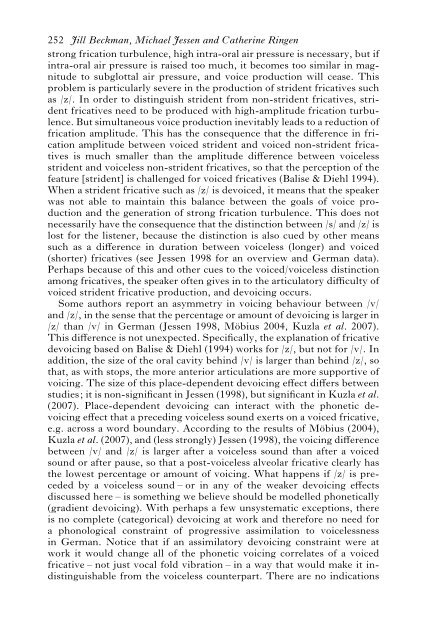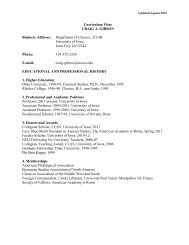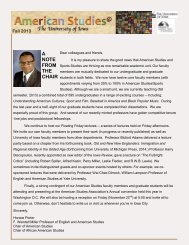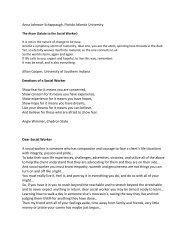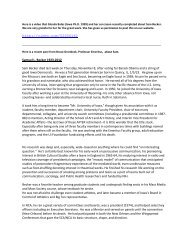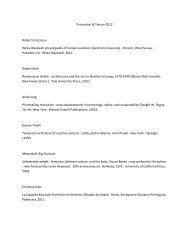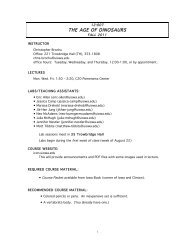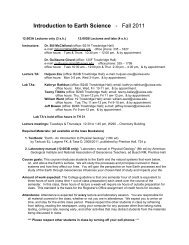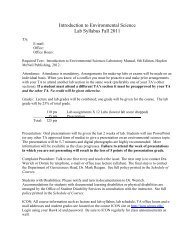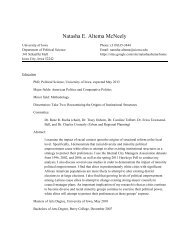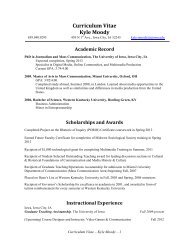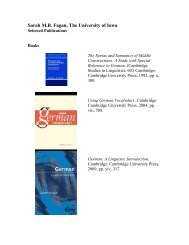German fricatives: coda devoicing or positional faithfulness?
German fricatives: coda devoicing or positional faithfulness?
German fricatives: coda devoicing or positional faithfulness?
You also want an ePaper? Increase the reach of your titles
YUMPU automatically turns print PDFs into web optimized ePapers that Google loves.
252 Jill Beckman, Michael Jessen and Catherine Ringen<br />
strong frication turbulence, high intra-<strong>or</strong>al air pressure is necessary, but if<br />
intra-<strong>or</strong>al air pressure is raised too much, it becomes too similar in magnitude<br />
to subglottal air pressure, and voice production will cease. This<br />
problem is particularly severe in the production of strident <strong>fricatives</strong> such<br />
as /z/. In <strong>or</strong>der to distinguish strident from non-strident <strong>fricatives</strong>, strident<br />
<strong>fricatives</strong> need to be produced with high-amplitude frication turbulence.<br />
But simultaneous voice production inevitably leads to a reduction of<br />
frication amplitude. This has the consequence that the difference in frication<br />
amplitude between voiced strident and voiced non-strident <strong>fricatives</strong><br />
is much smaller than the amplitude difference between voiceless<br />
strident and voiceless non-strident <strong>fricatives</strong>, so that the perception of the<br />
feature [strident] is challenged f<strong>or</strong> voiced <strong>fricatives</strong> (Balise & Diehl 1994).<br />
When a strident fricative such as /z/ is devoiced, it means that the speaker<br />
was not able to maintain this balance between the goals of voice production<br />
and the generation of strong frication turbulence. This does not<br />
necessarily have the consequence that the distinction between /s/ and /z/ is<br />
lost f<strong>or</strong> the listener, because the distinction is also cued by other means<br />
such as a difference in duration between voiceless (longer) and voiced<br />
(sh<strong>or</strong>ter) <strong>fricatives</strong> (see Jessen 1998 f<strong>or</strong> an overview and <strong>German</strong> data).<br />
Perhaps because of this and other cues to the voiced/voiceless distinction<br />
among <strong>fricatives</strong>, the speaker often gives in to the articulat<strong>or</strong>y difficulty of<br />
voiced strident fricative production, and <strong>devoicing</strong> occurs.<br />
Some auth<strong>or</strong>s rep<strong>or</strong>t an asymmetry in voicing behaviour between /v/<br />
and /z/, in the sense that the percentage <strong>or</strong> amount of <strong>devoicing</strong> is larger in<br />
/z/ than /v/ in <strong>German</strong> (Jessen 1998, Möbius 2004, Kuzla et al. 2007).<br />
This difference is not unexpected. Specifically, the explanation of fricative<br />
<strong>devoicing</strong> based on Balise & Diehl (1994) w<strong>or</strong>ks f<strong>or</strong> /z/, but not f<strong>or</strong> /v/. In<br />
addition, the size of the <strong>or</strong>al cavity behind /v/ is larger than behind /z/, so<br />
that, as with stops, the m<strong>or</strong>e anteri<strong>or</strong> articulations are m<strong>or</strong>e supp<strong>or</strong>tive of<br />
voicing. The size of this place-dependent <strong>devoicing</strong> effect differs between<br />
studies; it is non-significant in Jessen (1998), but significant in Kuzla et al.<br />
(2007). Place-dependent <strong>devoicing</strong> can interact with the phonetic <strong>devoicing</strong><br />
effect that a preceding voiceless sound exerts on a voiced fricative,<br />
e.g. across a w<strong>or</strong>d boundary. Acc<strong>or</strong>ding to the results of Möbius (2004),<br />
Kuzla et al. (2007), and (less strongly) Jessen (1998), the voicing difference<br />
between /v/ and /z/ is larger after a voiceless sound than after a voiced<br />
sound <strong>or</strong> after pause, so that a post-voiceless alveolar fricative clearly has<br />
the lowest percentage <strong>or</strong> amount of voicing. What happens if /z/ is preceded<br />
by a voiceless sound – <strong>or</strong> in any of the weaker <strong>devoicing</strong> effects<br />
discussed here – is something we believe should be modelled phonetically<br />
(gradient <strong>devoicing</strong>). With perhaps a few unsystematic exceptions, there<br />
is no complete (categ<strong>or</strong>ical) <strong>devoicing</strong> at w<strong>or</strong>k and theref<strong>or</strong>e no need f<strong>or</strong><br />
a phonological constraint of progressive assimilation to voicelessness<br />
in <strong>German</strong>. Notice that if an assimilat<strong>or</strong>y <strong>devoicing</strong> constraint were at<br />
w<strong>or</strong>k it would change all of the phonetic voicing c<strong>or</strong>relates of a voiced<br />
fricative – not just vocal fold vibration – in a way that would make it indistinguishable<br />
from the voiceless counterpart. There are no indications


